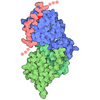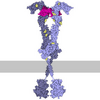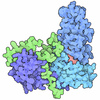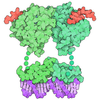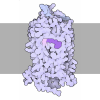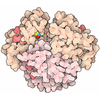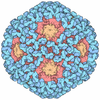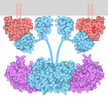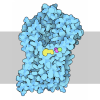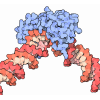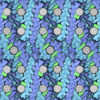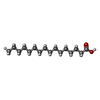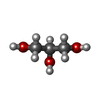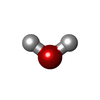[English] 日本語
 Yorodumi
Yorodumi- PDB-9iwl: X-ray structure of human PPARalpha ligand binding domain-intrinsi... -
+ Open data
Open data
- Basic information
Basic information
| Entry | Database: PDB / ID: 9iwl | |||||||||
|---|---|---|---|---|---|---|---|---|---|---|
| Title | X-ray structure of human PPARalpha ligand binding domain-intrinsic fatty acid (E. coli origin)-CBP coactivator peptide co-crystals obtained by cross-seeding | |||||||||
 Components Components |
| |||||||||
 Keywords Keywords | TRANSCRIPTION / Nuclear receptor / Protein-ligand complex / PPAR / Coactivator / CBP | |||||||||
| Function / homology |  Function and homology information Function and homology informationpositive regulation of transformation of host cell by virus / regulation of fatty acid transport / enamel mineralization / positive regulation of fatty acid beta-oxidation / regulation of ketone metabolic process / cellular response to fructose stimulus / regulation of fatty acid metabolic process / negative regulation of cell growth involved in cardiac muscle cell development / negative regulation of appetite / peptide lactyltransferase (CoA-dependent) activity ...positive regulation of transformation of host cell by virus / regulation of fatty acid transport / enamel mineralization / positive regulation of fatty acid beta-oxidation / regulation of ketone metabolic process / cellular response to fructose stimulus / regulation of fatty acid metabolic process / negative regulation of cell growth involved in cardiac muscle cell development / negative regulation of appetite / peptide lactyltransferase (CoA-dependent) activity / negative regulation of hepatocyte apoptotic process / lipoprotein metabolic process / positive regulation of fatty acid oxidation / behavioral response to nicotine / NFE2L2 regulating ER-stress associated genes / Activation of the TFAP2 (AP-2) family of transcription factors / NFE2L2 regulating inflammation associated genes / negative regulation of leukocyte cell-cell adhesion / histone H3K18 acetyltransferase activity / N-terminal peptidyl-lysine acetylation / histone H3K27 acetyltransferase activity / LRR FLII-interacting protein 1 (LRRFIP1) activates type I IFN production / NFE2L2 regulates pentose phosphate pathway genes / regulation of smoothened signaling pathway / NFE2L2 regulating MDR associated enzymes / MRF binding / negative regulation of glycolytic process / RUNX1 regulates transcription of genes involved in differentiation of myeloid cells / ubiquitin conjugating enzyme binding / Regulation of gene expression in late stage (branching morphogenesis) pancreatic bud precursor cells / Regulation of FOXO transcriptional activity by acetylation / RUNX3 regulates NOTCH signaling / mitogen-activated protein kinase kinase kinase binding / NOTCH4 Intracellular Domain Regulates Transcription / Nuclear events mediated by NFE2L2 / Regulation of NFE2L2 gene expression / Regulation of gene expression by Hypoxia-inducible Factor / NOTCH3 Intracellular Domain Regulates Transcription / negative regulation of transcription by RNA polymerase I / TRAF6 mediated IRF7 activation / NFE2L2 regulating tumorigenic genes / NFE2L2 regulating anti-oxidant/detoxification enzymes / embryonic digit morphogenesis / protein-lysine-acetyltransferase activity / protein acetylation / positive regulation of fatty acid metabolic process / DNA-binding transcription activator activity / homeostatic process / Notch-HLH transcription pathway / NFAT protein binding / Formation of paraxial mesoderm / positive regulation of transforming growth factor beta receptor signaling pathway / acetyltransferase activity / FOXO-mediated transcription of cell death genes / negative regulation of cholesterol storage / stimulatory C-type lectin receptor signaling pathway / Zygotic genome activation (ZGA) / TP53 Regulates Transcription of Genes Involved in Cytochrome C Release / positive regulation of ATP biosynthetic process / nuclear steroid receptor activity / histone acetyltransferase complex / negative regulation of macrophage derived foam cell differentiation / canonical NF-kappaB signal transduction / epidermis development / Attenuation phase / phosphatase binding / positive regulation of lipid biosynthetic process / histone acetyltransferase activity / cellular response to nutrient levels / Transcriptional regulation of brown and beige adipocyte differentiation by EBF2 / histone acetyltransferase / positive regulation of double-strand break repair via homologous recombination / regulation of cellular response to heat / negative regulation of blood pressure / intracellular receptor signaling pathway / nitric oxide metabolic process / negative regulation of reactive oxygen species biosynthetic process / hormone-mediated signaling pathway / : / NPAS4 regulates expression of target genes / Regulation of lipid metabolism by PPARalpha / MDM2/MDM4 family protein binding / peroxisome proliferator activated receptor signaling pathway / Transferases; Acyltransferases; Transferring groups other than aminoacyl groups / response to nutrient / positive regulation of gluconeogenesis / negative regulation of cytokine production involved in inflammatory response / Transcriptional and post-translational regulation of MITF-M expression and activity / negative regulation of phosphatidylinositol 3-kinase/protein kinase B signal transduction / CD209 (DC-SIGN) signaling / BMAL1:CLOCK,NPAS2 activates circadian expression / SUMOylation of transcription cofactors / Activation of gene expression by SREBF (SREBP) / negative regulation of miRNA transcription / cellular response to starvation / gluconeogenesis / SUMOylation of intracellular receptors / circadian regulation of gene expression / wound healing / Heme signaling Similarity search - Function | |||||||||
| Biological species |  Homo sapiens (human) Homo sapiens (human) | |||||||||
| Method |  X-RAY DIFFRACTION / X-RAY DIFFRACTION /  SYNCHROTRON / SYNCHROTRON /  MOLECULAR REPLACEMENT / Resolution: 2.09 Å MOLECULAR REPLACEMENT / Resolution: 2.09 Å | |||||||||
 Authors Authors | Kamata, S. / Honda, A. / Yashiro, S. / Komori, Y. / Shimamura, A. / Hosoda, A. / Oyama, T. / Ishii, I. | |||||||||
| Funding support |  Japan, 2items Japan, 2items
| |||||||||
 Citation Citation |  Journal: Antioxidants / Year: 2025 Journal: Antioxidants / Year: 2025Title: Competitive Ligand-Induced Recruitment of Coactivators to Specific PPAR alpha / delta / gamma Ligand-Binding Domains Revealed by Dual-Emission FRET and X-Ray Diffraction of Cocrystals. Authors: Kamata, S. / Honda, A. / Yashiro, S. / Kaneko, C. / Komori, Y. / Shimamura, A. / Masuda, R. / Oyama, T. / Ishii, I. | |||||||||
| History |
|
- Structure visualization
Structure visualization
| Structure viewer | Molecule:  Molmil Molmil Jmol/JSmol Jmol/JSmol |
|---|
- Downloads & links
Downloads & links
- Download
Download
| PDBx/mmCIF format |  9iwl.cif.gz 9iwl.cif.gz | 71.8 KB | Display |  PDBx/mmCIF format PDBx/mmCIF format |
|---|---|---|---|---|
| PDB format |  pdb9iwl.ent.gz pdb9iwl.ent.gz | 51.3 KB | Display |  PDB format PDB format |
| PDBx/mmJSON format |  9iwl.json.gz 9iwl.json.gz | Tree view |  PDBx/mmJSON format PDBx/mmJSON format | |
| Others |  Other downloads Other downloads |
-Validation report
| Summary document |  9iwl_validation.pdf.gz 9iwl_validation.pdf.gz | 637.7 KB | Display |  wwPDB validaton report wwPDB validaton report |
|---|---|---|---|---|
| Full document |  9iwl_full_validation.pdf.gz 9iwl_full_validation.pdf.gz | 642.1 KB | Display | |
| Data in XML |  9iwl_validation.xml.gz 9iwl_validation.xml.gz | 14.3 KB | Display | |
| Data in CIF |  9iwl_validation.cif.gz 9iwl_validation.cif.gz | 18.1 KB | Display | |
| Arichive directory |  https://data.pdbj.org/pub/pdb/validation_reports/iw/9iwl https://data.pdbj.org/pub/pdb/validation_reports/iw/9iwl ftp://data.pdbj.org/pub/pdb/validation_reports/iw/9iwl ftp://data.pdbj.org/pub/pdb/validation_reports/iw/9iwl | HTTPS FTP |
-Related structure data
| Related structure data |  9iwjC  9iwkC  9iwmC  9iwnC  9iwoC C: citing same article ( |
|---|---|
| Similar structure data | Similarity search - Function & homology  F&H Search F&H Search |
- Links
Links
- Assembly
Assembly
| Deposited unit | 
| ||||||||
|---|---|---|---|---|---|---|---|---|---|
| 1 |
| ||||||||
| Unit cell |
|
- Components
Components
| #1: Protein | Mass: 30856.053 Da / Num. of mol.: 1 Source method: isolated from a genetically manipulated source Source: (gene. exp.)  Homo sapiens (human) / Plasmid: pET28a / Production host: Homo sapiens (human) / Plasmid: pET28a / Production host:  |
|---|---|
| #2: Protein/peptide | Mass: 1945.141 Da / Num. of mol.: 1 / Source method: obtained synthetically / Source: (synth.)  Homo sapiens (human) Homo sapiens (human)References: UniProt: Q92793, histone acetyltransferase, Transferases; Acyltransferases; Transferring groups other than aminoacyl groups |
| #3: Chemical | ChemComp-PLM / |
| #4: Chemical | ChemComp-GOL / |
| #5: Water | ChemComp-HOH / |
| Has ligand of interest | Y |
| Has protein modification | N |
-Experimental details
-Experiment
| Experiment | Method:  X-RAY DIFFRACTION / Number of used crystals: 1 X-RAY DIFFRACTION / Number of used crystals: 1 |
|---|
- Sample preparation
Sample preparation
| Crystal | Density Matthews: 2.11 Å3/Da / Density % sol: 41.69 % |
|---|---|
| Crystal grow | Temperature: 277 K / Method: vapor diffusion Details: 0.1M Tris (pH 8.5), 30% PEG 4000, 0.2M Sodium acetate trihydrate |
-Data collection
| Diffraction | Mean temperature: 100 K / Serial crystal experiment: N |
|---|---|
| Diffraction source | Source:  SYNCHROTRON / Site: SYNCHROTRON / Site:  Photon Factory Photon Factory  / Beamline: BL-5A / Wavelength: 1 Å / Beamline: BL-5A / Wavelength: 1 Å |
| Detector | Type: DECTRIS PILATUS3 S 6M / Detector: PIXEL / Date: Jun 24, 2024 / Details: Mirrors |
| Radiation | Monochromator: Si(111) / Protocol: SINGLE WAVELENGTH / Monochromatic (M) / Laue (L): M / Scattering type: x-ray |
| Radiation wavelength | Wavelength: 1 Å / Relative weight: 1 |
| Reflection | Resolution: 2.09→42.06 Å / Num. obs: 16145 / % possible obs: 99.1 % / Redundancy: 3.3 % / CC1/2: 0.999 / Rmerge(I) obs: 0.046 / Rpim(I) all: 0.03 / Rrim(I) all: 0.055 / Net I/σ(I): 17.7 / Num. measured all: 53408 |
| Reflection shell | Resolution: 2.09→2.15 Å / Redundancy: 3.3 % / Rmerge(I) obs: 0.385 / Mean I/σ(I) obs: 3 / Num. unique obs: 1243 / CC1/2: 0.843 / Rpim(I) all: 0.248 / Rrim(I) all: 0.459 |
- Processing
Processing
| Software |
| |||||||||||||||||||||||||||||||||||||||||||||||||||||||||||||||||||||||||||||
|---|---|---|---|---|---|---|---|---|---|---|---|---|---|---|---|---|---|---|---|---|---|---|---|---|---|---|---|---|---|---|---|---|---|---|---|---|---|---|---|---|---|---|---|---|---|---|---|---|---|---|---|---|---|---|---|---|---|---|---|---|---|---|---|---|---|---|---|---|---|---|---|---|---|---|---|---|---|---|
| Refinement | Method to determine structure:  MOLECULAR REPLACEMENT / Resolution: 2.09→27.874 Å / SU ML: 0.24 / Cross valid method: FREE R-VALUE / σ(F): 1.94 / Phase error: 25.09 / Stereochemistry target values: ML MOLECULAR REPLACEMENT / Resolution: 2.09→27.874 Å / SU ML: 0.24 / Cross valid method: FREE R-VALUE / σ(F): 1.94 / Phase error: 25.09 / Stereochemistry target values: ML
| |||||||||||||||||||||||||||||||||||||||||||||||||||||||||||||||||||||||||||||
| Solvent computation | Shrinkage radii: 0.9 Å / VDW probe radii: 1.11 Å / Solvent model: FLAT BULK SOLVENT MODEL | |||||||||||||||||||||||||||||||||||||||||||||||||||||||||||||||||||||||||||||
| Refinement step | Cycle: LAST / Resolution: 2.09→27.874 Å
| |||||||||||||||||||||||||||||||||||||||||||||||||||||||||||||||||||||||||||||
| Refine LS restraints |
| |||||||||||||||||||||||||||||||||||||||||||||||||||||||||||||||||||||||||||||
| LS refinement shell |
|
 Movie
Movie Controller
Controller


 PDBj
PDBj

